An excellent move on Copenhagen's behalf. Nordic Syndicalists does sound troubling among the Baltic however.
The Grand Germanic Empire; A Kaiserreich AAR
- Thread starter TheSublimeGoose
- Start date
-
We have updated our Community Code of Conduct. Please read through the new rules for the forum that are an integral part of Paradox Interactive’s User Agreement.
You are using an out of date browser. It may not display this or other websites correctly.
You should upgrade or use an alternative browser.
You should upgrade or use an alternative browser.
Threadmarks
View all 9 threadmarks
Reader mode
Reader mode
Recent threadmarks
#1 - The German Empire in 1936 & the Black Monday Collapse #3 - New Imperial Law Enforcement Agencies; The Ukrainian Wheat Crisis #4 - The Belgian Rebellion and Integration #5 - The Implosion of Mittelafrika #6 - The Danish Integration; Icelandic Independence & Greenlandic Colonization #7 - The Ukrainian Syndicalist Rebellion #8 - WAR! The Second Weltkrieg & The Second American Civil War #9 - Manövrierkrieg, The Armored GauntletDenmark was lucky she wasn't annexed, I guess.
"Around zese parts, ve call it 'integration.'"
Deutschland Uber Alles plays softly in the distance
#7 - The Ukrainian Syndicalist Rebellion
Compared to other members of the Reichspakt, the Kingdom of Ukraine had maintained a great degree of autonomy, the Imperial government allotting more and more powers and authority to the Ukrainian Royal Government. This was partly due to Ukraine's distance from Berlin, but it was also due to the young Kingdom's relative pacificity. Ukrainian nationalists were pleased to finally enjoy their own nation and even their own King (even if he did speak German at court). Those on the left were pleased by the Kingdom's relatively liberal policies, guaranteeing a variety of freedoms and rights for all citizens. However, with the growing 'Soviet Syndicalist' movement in Russia, the syndicalist presence in Eastern Ukraine likewise ballooned. Soon, Russian, Ukranian, Ruthenian, and even Polish syndicalists gathered in Kharkiv, and began fomenting rebellion.
King Vasyl I von Habsburg-Lothringen of Ukraine, with strong familial ties to Germany -- and especially Austria -- had long guided the nation according to the directions of Berlin and Vienna. However, he was a lifelong Slavophile; He was especially interested in Ukrainian culture, something which endeared him to the populace. Seeking a better future for his people, Vasyl I had, in the early years of his reign, obtained a very lucrative trade deal for his new Kingdom. Germany and Austria were to allow artisan, mechanical, and military goods to flow freely into Ukraine, while the Kingdom would become the "Breadbasket of the East." Pre-existing farmers were given special subsidies, tax cuts, and even additional land by the government; any Ukrainian family that showed the aptitude and work-ethic would be granted plots of unused farmland at no cost by the government. This quickly led to an agricultural revolution in the Kingdom, and her citizens began to enjoy a level of wealth that they had never before imagined. However, as the post-Weltkrieg years dragged on, Ukrainian cities languished; all attention was focused on the country side and farms. Former urban industrial centers were closing rapidly; most goods were now imported cheaper than Ukrainian factories could make them. With an abundance of food, the population also exploded... and by 1935, a true problem had emerged.
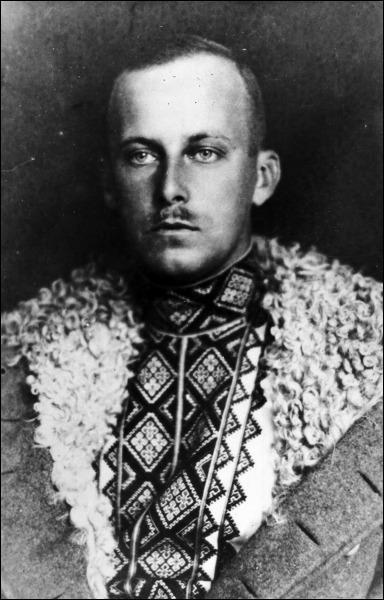
King Vasyl I von Habsburg-Lothringen of Ukraine; For a post-Weltkrieg, foreign-born monarch, Vasyl I was exceptionally popular, at least among certain segments of the population. While he was more closely related to the Austrian Imperial Family, Vasyl I saw that Austria-Hungary was a collapsing empire, and spent the post-First Weltkrieg years warming up to Imperial Germany. The Kaiser would go on to authorize massive loans and spending by German quasi-state-owned corporations in Ukraine. As the Imperial Army underwent its massive modernization program of 1935-1938, the Imperial High Command -- with the blessing of the Kaiser -- granted the fledgling Kingdom a huge percentage of its FW-era equipment. The Ukrainian Royal Army, increasingly drawing her recruits from the more-loyal countryside, would swell in size; the Royal Army often performed exercises alongside the Imperial Army. The Ukrainian Royal Navy (URN) was viewed by the Germans as strategically important in the security of the Black Sea and therefore, the Balkans, Crimea, and Ukraine herself; the Imperial Navy often gave older vessels to the URN.
King Vasyl I von Habsburg-Lothringen of Ukraine, with strong familial ties to Germany -- and especially Austria -- had long guided the nation according to the directions of Berlin and Vienna. However, he was a lifelong Slavophile; He was especially interested in Ukrainian culture, something which endeared him to the populace. Seeking a better future for his people, Vasyl I had, in the early years of his reign, obtained a very lucrative trade deal for his new Kingdom. Germany and Austria were to allow artisan, mechanical, and military goods to flow freely into Ukraine, while the Kingdom would become the "Breadbasket of the East." Pre-existing farmers were given special subsidies, tax cuts, and even additional land by the government; any Ukrainian family that showed the aptitude and work-ethic would be granted plots of unused farmland at no cost by the government. This quickly led to an agricultural revolution in the Kingdom, and her citizens began to enjoy a level of wealth that they had never before imagined. However, as the post-Weltkrieg years dragged on, Ukrainian cities languished; all attention was focused on the country side and farms. Former urban industrial centers were closing rapidly; most goods were now imported cheaper than Ukrainian factories could make them. With an abundance of food, the population also exploded... and by 1935, a true problem had emerged.

King Vasyl I von Habsburg-Lothringen of Ukraine; For a post-Weltkrieg, foreign-born monarch, Vasyl I was exceptionally popular, at least among certain segments of the population. While he was more closely related to the Austrian Imperial Family, Vasyl I saw that Austria-Hungary was a collapsing empire, and spent the post-First Weltkrieg years warming up to Imperial Germany. The Kaiser would go on to authorize massive loans and spending by German quasi-state-owned corporations in Ukraine. As the Imperial Army underwent its massive modernization program of 1935-1938, the Imperial High Command -- with the blessing of the Kaiser -- granted the fledgling Kingdom a huge percentage of its FW-era equipment. The Ukrainian Royal Army, increasingly drawing her recruits from the more-loyal countryside, would swell in size; the Royal Army often performed exercises alongside the Imperial Army. The Ukrainian Royal Navy (URN) was viewed by the Germans as strategically important in the security of the Black Sea and therefore, the Balkans, Crimea, and Ukraine herself; the Imperial Navy often gave older vessels to the URN.
Those born just before, during, and immediately after the First Weltkrieg were -- especially if they lived in the cities -- immensely resentful of the thought of single families taking up as much land that could house thousands within a city. This generation quickly trended towards syndicalism, and most cities became hotbeds of agitation, often funded by Soviet, British, or French syndicalists. Agents of the German Kaiserliche Geheimpolizei (KGP) and of the Ukrainian Korolivsʹka Politsiya Osoblyvoyi Bezpeky (KPOB; Royal Special Security Police) began infiltration of syndicalist organizations and communes in Ukraine, around the same time the KGP were doing the same in Germany. This joint operation, while not as tremendously successful as said efforts in Germany, were still worthwhile. By the beginning of 1937, the KBOP was confident of syndicalist plans -- they intended to revolt. The KGP concurred with this assessment, and advised Berlin thusly. The Kaiser was quick to act, ordering the Kaiserliche Oberste Heeresleitung (KOHL; Imperial Supreme Army Command) to, "...as subtly and as covertly as possible, prepare for the invasion and subsequent restoration of order to The Ukraine." The KOHL, with little fanfare, decided to constitute a new command in Eastern Europe, in order to have a manager of strategic operations at the highest level, but who is also on-location, reporting to the KOHL; this, instead of various units in Eastern Europe reporting directly to the KOHL. This new command, Heeresgruppe Ost (HGO; Army Group East), was also to remain permanently established; The KOHL intended to use this command as an active effort in deterring any future Russian aggression.
In early 1937, various Imperial Armees began to make their way, via train, through the Duchy of Lithuania and Kingdom of White Ruthenia, towards the Ruthenian-Ukrainian border. In the past two years, the Imperial government had authorized massive investments in the transportation infrastructure of Lithuania and Ruthenia, precisely for this reason. It paid off, as dozens of divisions were able to promptly secure the border and prepare for invasion; all while logistical support was able to flow freely. Ostensibly, the divisions were on the border to participate in an annual war game with Ukraine; however, the HGO made sure that its various Armees kept the majority of their forces behind the front line, a few miles into Ruthenia. This was to ensure that any syndicalist presence in Ukraine would only report the normal number of German divisions participating in the annual war games; and not ten times that number.
The Armees mainly consisted of cavalry divisions; thought to be an ideal choice for the open countryside of the 'Breadbasket of the East,' while sparing the newer motorized and panzer divisions for the French border. Several infantry divisions were involved; these would primarily be utilized in mopping-up operations and for assaulting & securing any cities that might fall to syndicalists. Various units of the Kaiserliche Feldgendarmerie stood by to assume peacekeeping duties and to assist the various still-loyal Ukrainian law enforcement agencies.
By 9 January 1937, cities were overrun by local syndicalist communes, and the "Socialist Republic of Ukraine" was declared. While France and Britain promised full financial and covert military support, they stopped short of inviting the new socialist-syndicalist regime into the Internationale; Neither nation was prepared to risk all-out war with Imperial Germany over a nation of little strategic importance to the Internationale. By 10 January, a surprisingly potent syndicalist militia had assembled itself at the Ruthenian-Ukrainian border, leading Berlin to consider the possibility that the KGP or KBOP had been infiltrated itself; but it was no matter.
With the Ukrainian Royal Family secure in neighboring Ruthenia, an ultimatum was issued to the syndicalist troops on the border; Lay down your arms, return home, or suffer the consequences; the militias were bombarded by the Imperial Air Force with leaflets containing the message, along with a reminder that every leaflet would be a bomb instead within hours. With little command centralization, no order of surrender would be given, and thus, the Imperial army pushed forward. Under the cover of intense close air support -- a test case for the new air force -- the militias quickly melted. Within a day, Imperial cavalrymen were once again advancing deep into the heart of Ukraine.

Imperial cavalrymen ride past a stream of Ukrainian syndicalist militiia POWs. The militias were armed in a smattering of equipment ranging from French helmets, to Russian coats. Many went into battle with pre-FW weapons, a testament to the spirit of the Ukrainian people.
Within a week, dozens of German divisions were scattered across Ukraine, and the Kingdom -- the 'breadbasket' -- was secure. The King was quickly placed back into power, with Imperial troops to hold the line. Ukraine would recover rather quickly, mostly due to its strong & loyal farming class remaining resolute supporters of the government and her Imperial ally.
In our next lesson.... WAR!
Last edited:
This is a really interesting AAR, well written too, excited to follow it and see where it goes!
I was wondering though - the Reich seems to have a lot of military commitments, from the newly conquered Belgium, to Denmark, to now sending a Garrison to Ukraine; will this lead to the Germans being over-extended, and have possible consequences on the Second Weltkrieg?
I was wondering though - the Reich seems to have a lot of military commitments, from the newly conquered Belgium, to Denmark, to now sending a Garrison to Ukraine; will this lead to the Germans being over-extended, and have possible consequences on the Second Weltkrieg?
This is a really interesting AAR, well written too, excited to follow it and see where it goes!
I was wondering though - the Reich seems to have a lot of military commitments, from the newly conquered Belgium, to Denmark, to now sending a Garrison to Ukraine; will this lead to the Germans being over-extended, and have possible consequences on the Second Weltkrieg?
Thanks a ton!
And yeah; This fact will become evident as the 2WK breaks out, Germany is definitely spread extremely thin.
#8 - WAR! The Second Weltkrieg & The Second American Civil War
With the destruction of the syndicalist 'Socialist Republic of Ukraine,' The Empire had once again used military power to enforce its influence. Across Europe, Germany was responsible for rising tensions; Her annexation of Belgium and Denmark, the Poles bowing to German power, and the enforcement of (German) order in Ukraine worried all syndicalist strategists and commentators. Germany was clearly cementing her role as the dominant world 'mega-power,' a term born in the mid-1930s to describe the rise of individual nations that exert disproportionate influence and power over the rest of the world.
The Internationale; officially consisting of, in 1937; the Union of Britain, the Commune of France, the Commune of Sweden, and the Commune of Norway; met in Paris, in August of 1937. Officially, the only agenda was "...to further the Glorious People's Revolution..." but unofficially, two items were of priority. First, The Internationale discussed how much support would be proffered to any syndicalist revolution in the United States of America. Rising tensions in the states, along with a myriad of other issues, had already fractured the nation; it was merely a matter of time until an 'official' breakup was finalized. Secondly, "...containment of German Imperial aggression, here in Europe, as well as globally, [was] of the highest priority." The Internationale had noted that Imperial military commitments had spread her forces thin; very thin. Thus, a hard line was taken; Any further Imperial aggression towards any syndicalist nation would be treated as an affront to all syndicalist nations, and would be acted upon accordingly.
In response to this, the KOHL (Imperial Supreme Army Command) ordered Heeresgruppe West (Army Group West) to began a massive fortification update on the Franco-Imperial border. In addition, the newly-independent Kaiserliche Luftwaffe (KL; Imperial Air Force) made no effort to hide their movements; light and medium fighter units were moved to newly upgraded bases near the border. Heavy fighter units were in held in reserve in the heartland of Germany, to serve in the zerstörer or 'bomber-destroyer' role. The Air Force had also placed an equal emphasis on close air support (CAS) and strategic bombing (SB), and had reserves -- although somewhat small -- of both types of aircraft. The ground-attackers, however, had shone in their CAS during the Ukrainian intervention, and thus the KL did begin to trend towards focusing on CAS and light bombers. This latter decision would prove to be hugely helpful in the coming months.

KL Pilots and Airmen of Jagdgeschwader 16 pose before a Bayerische Flugzeugwerke (BFW) Bf-109 C-4. The 109 was tested as a possible replacement for the aging Fokker D.XXI (the first monoplane of the KL), the KL's primary light fighter. While many pilots praised the 109's maneuverability, low-altitude rate-of-climb, and relatively heavy armament for a light fighter, the design ultimately lost out to the Heinkel He-100. While early models of the He-100 were outgunned by the Bf-109; The 100 sporting x4 7.92mm machine guns; while the 109 was armed with x2 7.92mm machine guns, an engine-mounted MG-FF/M cannon, and two under-wing (or wing-root) mounted MG-FF/M gunpods; Heinkel assured the KL that the 100 could be up-armed without any performance penalties (which it would be; later models would even bear up to x2 12.7mm HMGs and up to x3 20 or 30mm minengeschoss cannons). Indeed, performance was the primary reason the 100 was chosen over the 109; the 100 went on to set world speed records, and was continually upgraded throughout the war. The 109 would be adopted instead as the KL's primary medium fighter in 1937. The KL was unique, in that it was the only Air Force to classify fighters into the light/medium/heavy classes. As a medium fighter, the 109 was called upon to function as a fighter-bomber, supplementing ground-attackers; and as a high-speed interceptor, when heavy fighter armament wasn't called for, but speed was. The 109 would continue in service around the world, after the end of the 2WK. Of particular note was the German-Jewish pilots whom served in the 2WK and then joined the new Jewish State of Madagascar's Air Force. The Madagascan Air Force was equipped with late-model 109s by the Imperial government. In support of the Jewish Evacuation in Palestine, the 109s were flown from Madagascar to the Imperial air base at the Suez Canal, and then flew sorties over Palestine in support of Madagascan ground troops and Imperial Marines.
Within a month of The Internationale's blanket guarantee of any aspiring syndicalist nation, the Netherlands would fall. Early in the morning on 7 September 1937, Queen Wilhelmina was forced to abdicate her throne and flee her Kingdom. She, much like monarchs before her, called upon the Kaiser to reclaim her nation from the radicals now running it; The Germans were unprepared to allow an ally of their greatest foes to lie so deeply in on German territory.
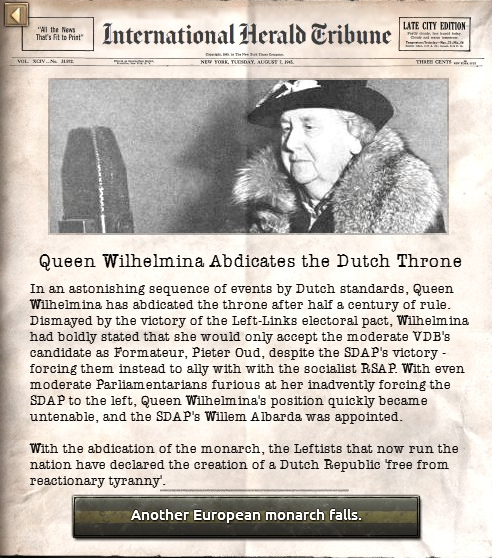
According to contemporary reports, Wilhemina was lucky to escape with her life, and only dedicated troops of her Royal bodyguard unit were able to guarantee her safety while traveling.
The KOHL spared no time in directing all forces on peacekeeping duties in Flanders-Wallonia and Denmark (the peace was not hard to keep in either, prospering constituent state, anymore) to the Dutch border. With relentless ground-attack from the KL, tens of thousands of Imperial infantrymen and cavalrymen swarmed across the Dutch border, their disorganized ' Batavian People's Army' quickly collapsing under the pressure.
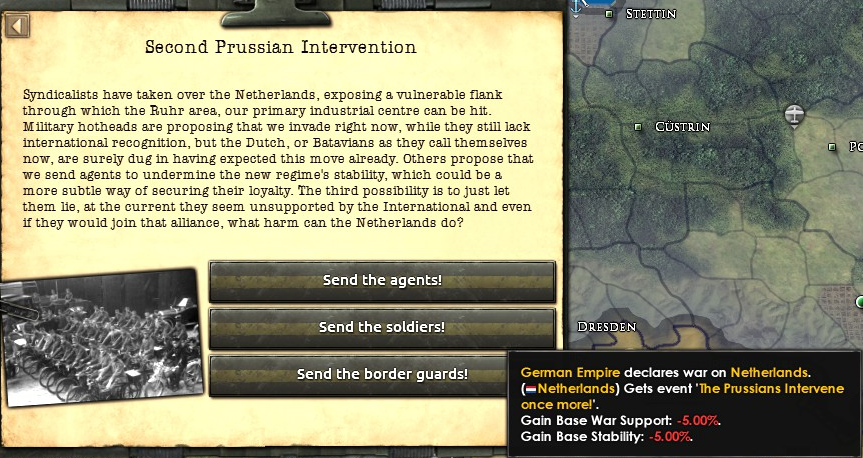
The 'Second Prussian Intervention,' as it would become known, was described in the press as "Yet another quick jaunt across the border." Neither the government nor the press truly believed The Internationale would respond as they had promised should another syndicalist nation's sovereignty be violated; They were wrong.
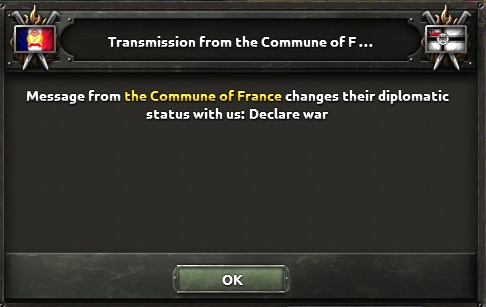
With the collapse of the Batavian Commune, the final straw had been placed. The Internationale officially declared war on The Empire, and her allies & subjects, on 12 September 1937, widely recognized as the start of the 2WK.
Imperial infantrymen on the border prepared to man their new defensive positions, while the new panzer and motorized divisions prepared, behind the lines, for a new tactic, the 'armored spearhead.' From Dunkirk to Mühlhausen, a hard line, called the Kaiserlinie (the Emperor's line) by Imperial troops, was drawn. The French would vastly overestimate how spread thin the Imperial Army was, and how greatly underestimate the new German fortifications; and would take the disastrous first steps of the war. Tens of thousands of Fernch troops, utilizing 1WK tactics against 2WK weaponary, were marched into the Kaiserlinie as if into a meat grinder. Within days, the Commune had "replaced" her generals on the border, and these tactics stopped. British transports, in order to avoid the now-massive Imperial Navy, skirted across the English Channel just days before the war began. The French quickly swept into Switzerland, and Swiss syndicalists quickly declared the the 'Helvetic Commune' had voluntarily joined The Internationale.
Rushing to defend this new and vulnerable border, the Kaiser personally ordered the 4. Jäger-Armee to the Imperial-Swiss border. The 4. Jäger-Armee was a new venture, concentrating the specialist units of the Imperial Army under one command. Most Gebirgsjäger, Alpenjäger, and Ski-Jäger (mountain troops) units were assigned the 4. Jäger-Armee; The KOHL also assigned new, experimental units, the 1., 2., 3., 4., & 5. Marine-Sturm-Division. The German military had not wielded proper Marines for decades, and thus this would be the initial test for them. The Marines would accompany their mountain-soldier brethren (most Marines had been selected directly from the various mountain units) to the Swiss border, and would defend this precarious position well. Once the border had been secured, the Marines would be sent to Dunkirk, where they began planning their invasion of the Union of Britain.
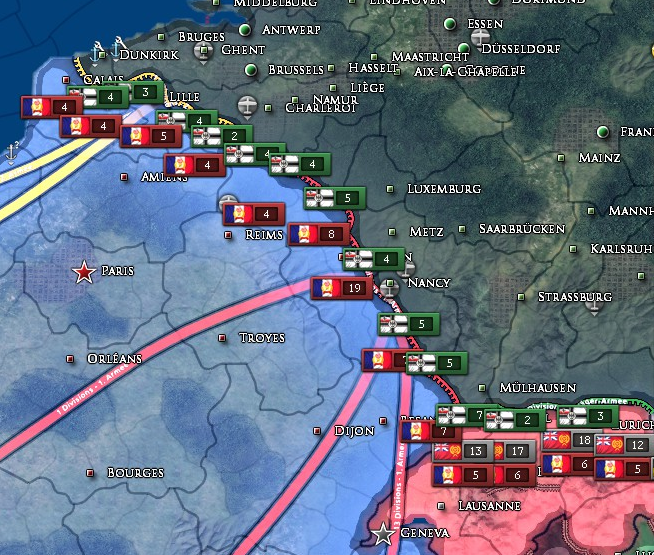
The Franco-Imperial and Imperial-Swiss border on 12 September 1937; The outrbeak of the Second Weltkrieg

An Imperial Marine in the early-war uniform. Note the Karabiner 98 kurz; While standard infantrymen would utilize the Kar 98 into the mid-war era and beyond, Marines quickly replaced it with a rugged, all-purpose, rifle-caliber, select-fire weapon, the MjG 42 or Marinejägergewehr 42. Marines, already selected from the most elite mountain troops, would quickly gain a reputation as the Kaiserreich's most elite troops. While nominally Naval servicemen, they were seconded to the KOHL. The Army would vie for ever more control over them, particularly as they grew in prestige; while the Navy would fight to maintain control. Eventually, a compromise was reached; The Marines would become an autonomous arm of the Navy, with its own rank structure and their own command staff (including a flag officer equivalent to the Großadmiral of the Imperial Navy; the General der Marine-Jäger) about halfway through the 2WK.
Meanwhile, across the Atlantic, the chaos of the start of yet another Great War collapsed the already-teetering United States of America. The nation would ostensibly split into 3 nation-states, although the federal government held on in the Midwest, and the northern South Atlantic region/Greater Washington D.C. area for several months. However, the main contenders for the American state were the Combined Syndicates of America in the North and Northeast; the American Union State in the eastern-Midwest, the South, and the southernmost-Northeast; and the Pacific States of America on the West Coast. The federal government held virtually no de facto authority over all of the regions they claimed to maintain control over, and within months, all territory save for Washington D.C. proper were occupied by either the PSA, CSA, or AUS.
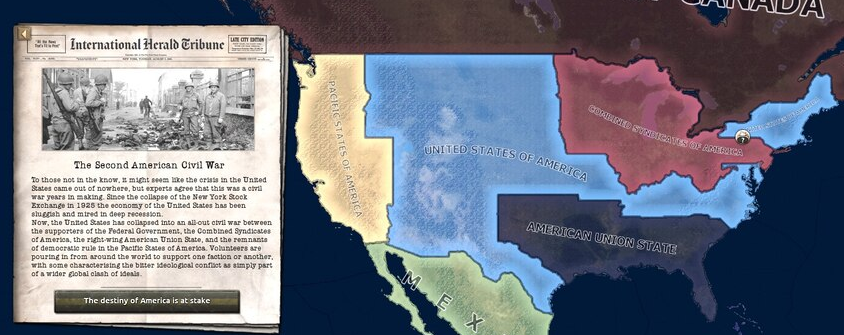
A contemporary tactical map shows the situation on the eve of the 2ACW. Note that while the federal government claimed large swathes of the nation, actual control of most of the areas would quickly fall under one of the new successor-states.
The Internationale; officially consisting of, in 1937; the Union of Britain, the Commune of France, the Commune of Sweden, and the Commune of Norway; met in Paris, in August of 1937. Officially, the only agenda was "...to further the Glorious People's Revolution..." but unofficially, two items were of priority. First, The Internationale discussed how much support would be proffered to any syndicalist revolution in the United States of America. Rising tensions in the states, along with a myriad of other issues, had already fractured the nation; it was merely a matter of time until an 'official' breakup was finalized. Secondly, "...containment of German Imperial aggression, here in Europe, as well as globally, [was] of the highest priority." The Internationale had noted that Imperial military commitments had spread her forces thin; very thin. Thus, a hard line was taken; Any further Imperial aggression towards any syndicalist nation would be treated as an affront to all syndicalist nations, and would be acted upon accordingly.
In response to this, the KOHL (Imperial Supreme Army Command) ordered Heeresgruppe West (Army Group West) to began a massive fortification update on the Franco-Imperial border. In addition, the newly-independent Kaiserliche Luftwaffe (KL; Imperial Air Force) made no effort to hide their movements; light and medium fighter units were moved to newly upgraded bases near the border. Heavy fighter units were in held in reserve in the heartland of Germany, to serve in the zerstörer or 'bomber-destroyer' role. The Air Force had also placed an equal emphasis on close air support (CAS) and strategic bombing (SB), and had reserves -- although somewhat small -- of both types of aircraft. The ground-attackers, however, had shone in their CAS during the Ukrainian intervention, and thus the KL did begin to trend towards focusing on CAS and light bombers. This latter decision would prove to be hugely helpful in the coming months.

KL Pilots and Airmen of Jagdgeschwader 16 pose before a Bayerische Flugzeugwerke (BFW) Bf-109 C-4. The 109 was tested as a possible replacement for the aging Fokker D.XXI (the first monoplane of the KL), the KL's primary light fighter. While many pilots praised the 109's maneuverability, low-altitude rate-of-climb, and relatively heavy armament for a light fighter, the design ultimately lost out to the Heinkel He-100. While early models of the He-100 were outgunned by the Bf-109; The 100 sporting x4 7.92mm machine guns; while the 109 was armed with x2 7.92mm machine guns, an engine-mounted MG-FF/M cannon, and two under-wing (or wing-root) mounted MG-FF/M gunpods; Heinkel assured the KL that the 100 could be up-armed without any performance penalties (which it would be; later models would even bear up to x2 12.7mm HMGs and up to x3 20 or 30mm minengeschoss cannons). Indeed, performance was the primary reason the 100 was chosen over the 109; the 100 went on to set world speed records, and was continually upgraded throughout the war. The 109 would be adopted instead as the KL's primary medium fighter in 1937. The KL was unique, in that it was the only Air Force to classify fighters into the light/medium/heavy classes. As a medium fighter, the 109 was called upon to function as a fighter-bomber, supplementing ground-attackers; and as a high-speed interceptor, when heavy fighter armament wasn't called for, but speed was. The 109 would continue in service around the world, after the end of the 2WK. Of particular note was the German-Jewish pilots whom served in the 2WK and then joined the new Jewish State of Madagascar's Air Force. The Madagascan Air Force was equipped with late-model 109s by the Imperial government. In support of the Jewish Evacuation in Palestine, the 109s were flown from Madagascar to the Imperial air base at the Suez Canal, and then flew sorties over Palestine in support of Madagascan ground troops and Imperial Marines.
Within a month of The Internationale's blanket guarantee of any aspiring syndicalist nation, the Netherlands would fall. Early in the morning on 7 September 1937, Queen Wilhelmina was forced to abdicate her throne and flee her Kingdom. She, much like monarchs before her, called upon the Kaiser to reclaim her nation from the radicals now running it; The Germans were unprepared to allow an ally of their greatest foes to lie so deeply in on German territory.

According to contemporary reports, Wilhemina was lucky to escape with her life, and only dedicated troops of her Royal bodyguard unit were able to guarantee her safety while traveling.
The KOHL spared no time in directing all forces on peacekeeping duties in Flanders-Wallonia and Denmark (the peace was not hard to keep in either, prospering constituent state, anymore) to the Dutch border. With relentless ground-attack from the KL, tens of thousands of Imperial infantrymen and cavalrymen swarmed across the Dutch border, their disorganized ' Batavian People's Army' quickly collapsing under the pressure.

The 'Second Prussian Intervention,' as it would become known, was described in the press as "Yet another quick jaunt across the border." Neither the government nor the press truly believed The Internationale would respond as they had promised should another syndicalist nation's sovereignty be violated; They were wrong.

With the collapse of the Batavian Commune, the final straw had been placed. The Internationale officially declared war on The Empire, and her allies & subjects, on 12 September 1937, widely recognized as the start of the 2WK.
Imperial infantrymen on the border prepared to man their new defensive positions, while the new panzer and motorized divisions prepared, behind the lines, for a new tactic, the 'armored spearhead.' From Dunkirk to Mühlhausen, a hard line, called the Kaiserlinie (the Emperor's line) by Imperial troops, was drawn. The French would vastly overestimate how spread thin the Imperial Army was, and how greatly underestimate the new German fortifications; and would take the disastrous first steps of the war. Tens of thousands of Fernch troops, utilizing 1WK tactics against 2WK weaponary, were marched into the Kaiserlinie as if into a meat grinder. Within days, the Commune had "replaced" her generals on the border, and these tactics stopped. British transports, in order to avoid the now-massive Imperial Navy, skirted across the English Channel just days before the war began. The French quickly swept into Switzerland, and Swiss syndicalists quickly declared the the 'Helvetic Commune' had voluntarily joined The Internationale.
Rushing to defend this new and vulnerable border, the Kaiser personally ordered the 4. Jäger-Armee to the Imperial-Swiss border. The 4. Jäger-Armee was a new venture, concentrating the specialist units of the Imperial Army under one command. Most Gebirgsjäger, Alpenjäger, and Ski-Jäger (mountain troops) units were assigned the 4. Jäger-Armee; The KOHL also assigned new, experimental units, the 1., 2., 3., 4., & 5. Marine-Sturm-Division. The German military had not wielded proper Marines for decades, and thus this would be the initial test for them. The Marines would accompany their mountain-soldier brethren (most Marines had been selected directly from the various mountain units) to the Swiss border, and would defend this precarious position well. Once the border had been secured, the Marines would be sent to Dunkirk, where they began planning their invasion of the Union of Britain.

The Franco-Imperial and Imperial-Swiss border on 12 September 1937; The outrbeak of the Second Weltkrieg

An Imperial Marine in the early-war uniform. Note the Karabiner 98 kurz; While standard infantrymen would utilize the Kar 98 into the mid-war era and beyond, Marines quickly replaced it with a rugged, all-purpose, rifle-caliber, select-fire weapon, the MjG 42 or Marinejägergewehr 42. Marines, already selected from the most elite mountain troops, would quickly gain a reputation as the Kaiserreich's most elite troops. While nominally Naval servicemen, they were seconded to the KOHL. The Army would vie for ever more control over them, particularly as they grew in prestige; while the Navy would fight to maintain control. Eventually, a compromise was reached; The Marines would become an autonomous arm of the Navy, with its own rank structure and their own command staff (including a flag officer equivalent to the Großadmiral of the Imperial Navy; the General der Marine-Jäger) about halfway through the 2WK.
Meanwhile, across the Atlantic, the chaos of the start of yet another Great War collapsed the already-teetering United States of America. The nation would ostensibly split into 3 nation-states, although the federal government held on in the Midwest, and the northern South Atlantic region/Greater Washington D.C. area for several months. However, the main contenders for the American state were the Combined Syndicates of America in the North and Northeast; the American Union State in the eastern-Midwest, the South, and the southernmost-Northeast; and the Pacific States of America on the West Coast. The federal government held virtually no de facto authority over all of the regions they claimed to maintain control over, and within months, all territory save for Washington D.C. proper were occupied by either the PSA, CSA, or AUS.

A contemporary tactical map shows the situation on the eve of the 2ACW. Note that while the federal government claimed large swathes of the nation, actual control of most of the areas would quickly fall under one of the new successor-states.
While The Empire had another Great War on her hands, the Kaiser personally authorized arms shipments to the American Union State, and sent a 'Letter of Friendship and Support' to President Huey Long himself. The Empire would, over the course of the next few years, ship hundreds of thousands of small-arms (albeit outdated models), old artillery, and even 'war-weary' fighter aircraft to the AUS. The 2ACW would rage on for years; even with heavy German support -- including volunteer divisions of 2WK-experienced combat veterans once the War in Europe was nearly over -- the AUS would struggle against syndicalist traitors to the north and separatist vipers to the west for years to come.
In our next lesson; The experimental 'armored spearhead' smashes through French lines, and 'The Long Advance' across France begins; German Marines fall back from the Imperial-Swiss border once syndicalist attacks slow, and prepare for an invasion of the UoB; the UoB launches a surprise naval-invasion of North Denmark, and it's up to German military policemen to repel.
In our next lesson; The experimental 'armored spearhead' smashes through French lines, and 'The Long Advance' across France begins; German Marines fall back from the Imperial-Swiss border once syndicalist attacks slow, and prepare for an invasion of the UoB; the UoB launches a surprise naval-invasion of North Denmark, and it's up to German military policemen to repel.
Last edited:
Good luck - a lot of british soldiers in Switzerland it looks like - maybe they will suffer from lack of supplies?
Dark times are ahead. Let's hope that France is knocked out of the war with a brutal 'one-two' punch
Very interesting read. One question about the mod mechanics behind the AAR: how did the danish annexation actually occur? The shown event speaks just of joining your faction. Is the annexation another event that happens normally, or a narrative license?
Yeah, the latter. I just used the state-transfer tool. I'll probably create a custom event for these sort of things, if anyone has an interest in re-playing this campaign.Very interesting read. One question about the mod mechanics behind the AAR: how did the danish annexation actually occur? The shown event speaks just of joining your faction. Is the annexation another event that happens normally, or a narrative license?
I stationed a bunch of my MP units in the newly annexed territories to reflect the security efforts taken in occupying Danish lands, and ideally there'd be an event that give me some mild penalties for a time.
#9 - Manövrierkrieg, The Armored Gauntlet
With German defenses shoring up, troops on both sides of the Imperial-French-Swiss border settled in for a defensive trench war, a la the First Weltkrieg. Unbeknowst to the French and British, however, Imperial forces were massing their armored forces in the north of the Kingdom of Flanders-Wallonia. Both French and British doctrines held that armored brigades and divisions were to be dispersed among their various corps, and were to be employed in purely infantry support and mopping-up operations. Within The Empire, however, a new line of tactical and strategic thinking was emerging, set out by visionaries such as General der Panzertruppe Heinz Guderian and Generalleutnant Erwin Rommel. While British and French (and even the occasional Swiss) panzers outnumbered Imperial armored forces, they did not have the quality of German panzers. To overcome this, both generals promoted the concept of Manövrierkrieg (war of maneuver), and advocated for the use of panzers en masse, to be used as an armored gauntlet, smashing through enemy lines.
While more traditionalist infantry-branch generals maintained that their branch would ultimately win the war, the cavalry branch (as well as the soon-to-be independent armor branch) and the Luftwaffe enthusiastically supported Manövrierkrieg. Thus, the Kaiser ordered the Kaiserliche Oberste Heeresleitung (KOHL; Imperial Supreme Army Command) to attempt the Manövrierkrieg tactic in northern France. Thus, the panzer build-up in Flanders-Wallonia. General der Panzertruppe Guderian personally took charge of the overall operation, even managing to have infantry and cavalry divisions transferred to his corps. Generalleutnant Rommel was to command the panzer divisions on the ground.
In 1937, Imperial armored forces consisted mainly of LP Is and LP IIs (Leichter-Panzer I & II; Light Panzer 1 & 2), although some units had begun to be outfitted with the MP I (Mittlerer-Panzer I; Medium Panzer 1) 'Donnerschlag.' The Donnerschlag was, for 1937, a panzer ahead of its time. Its unintentionally mildly sloped armor proved to be far more effective than the armor of lighter tanks, and the wide variety of main guns and MGs available in different variants provided for a Donnerschlag for every situation.
The Kaiserliche Luftwaffe enthusiastically supported this form of warfare, and prepared all available Schlachtgeschwader (ground-attack wings) for operational service. Fuel was a mild concern, but it was felt that if the armored gauntlet could move quickly enough; or at least smash the enemy's front-lines enough for infantry and cavalrymen to flood through; then all could be accomplished within a margin of safety without running out of strategic fuel reserves. The Kaiserliche Kriegsmarine (Imperial Navy) was limited to coastal patrol operations, and only the area of the main naval port, the Kaiserliche Werft Wilhelmshaven (Wilhelmshaven Imperial Port) was protected with any real zeal.
With the winter of '37, lines solidified, and WWI-style defensive warfare was the name of the game. However, in May of '38, the 'armored gauntlet' was pushed through, and Manövrierkrieg would go into the history books as General der Panzertruppe Heinz Guderian and Generalleutnant Erwin Rommel executed their long-prepared armored attack. French lines in the north, while densely packed with Syndicalist infantrymen and naval battalions, the concentration of medium panzers to make the initial breakthrough, and light panzers to mop up the infantry, simply melted the once-stolid French frontlines.
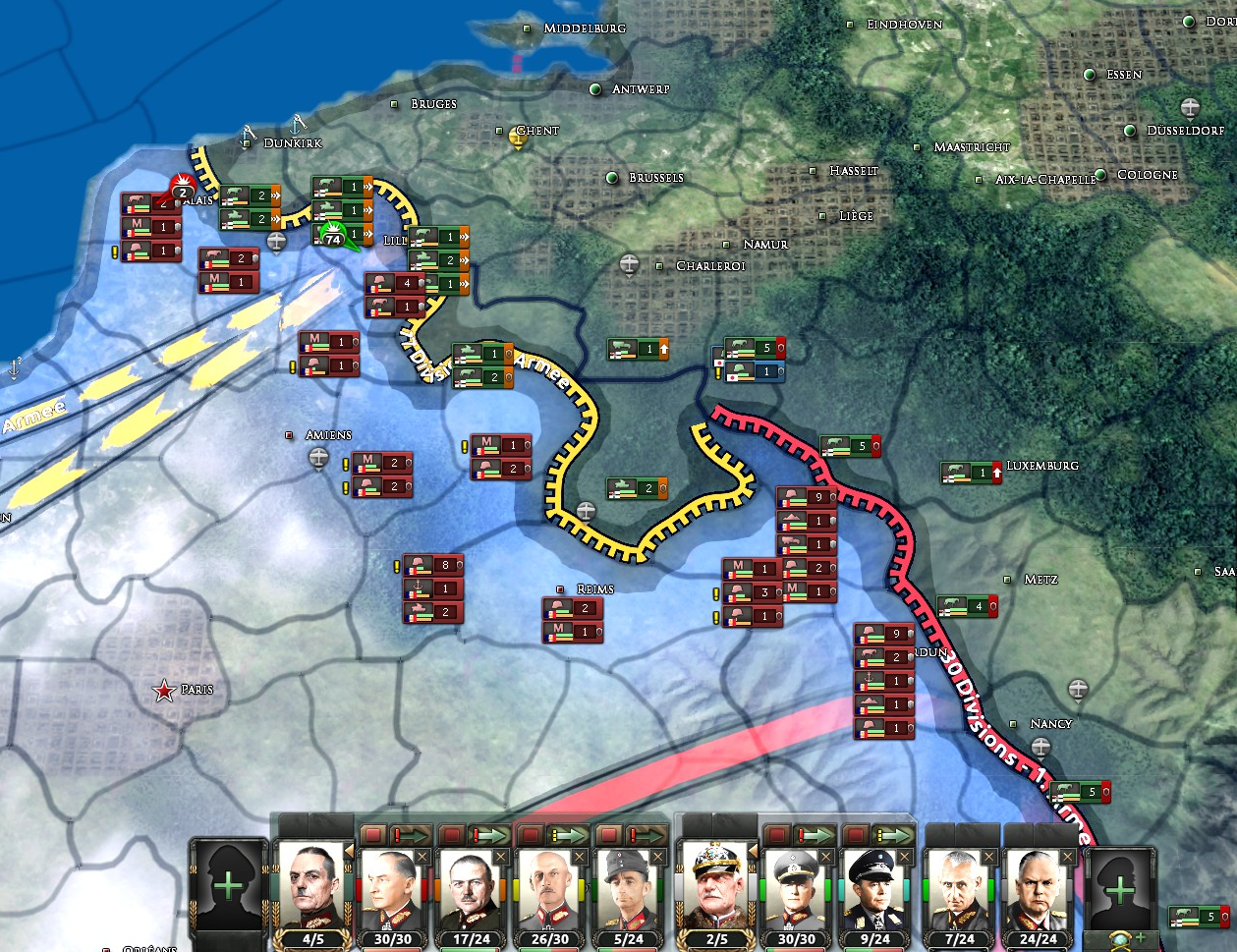
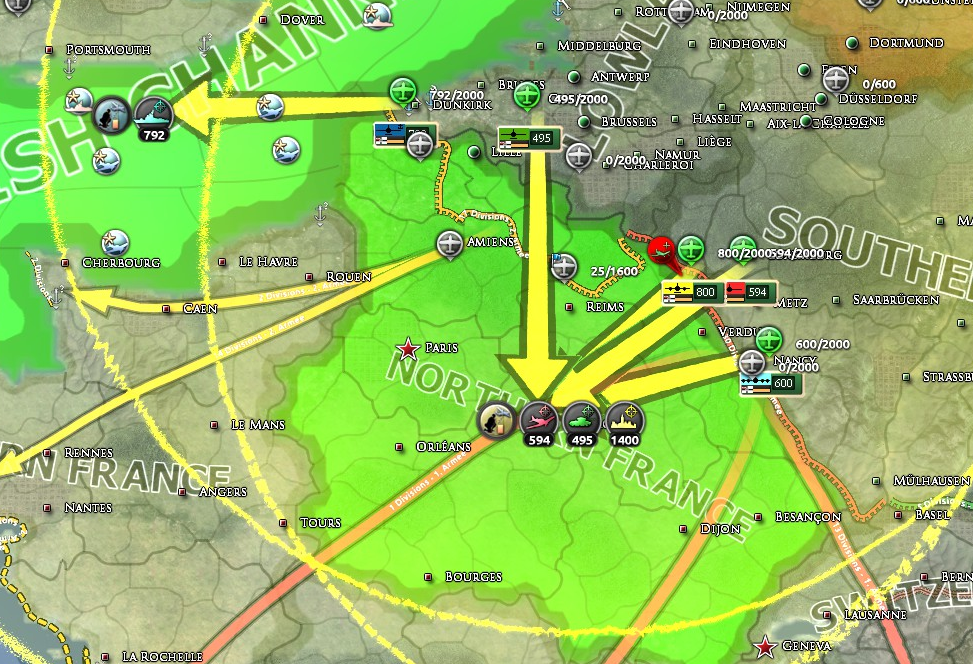
While more traditionalist infantry-branch generals maintained that their branch would ultimately win the war, the cavalry branch (as well as the soon-to-be independent armor branch) and the Luftwaffe enthusiastically supported Manövrierkrieg. Thus, the Kaiser ordered the Kaiserliche Oberste Heeresleitung (KOHL; Imperial Supreme Army Command) to attempt the Manövrierkrieg tactic in northern France. Thus, the panzer build-up in Flanders-Wallonia. General der Panzertruppe Guderian personally took charge of the overall operation, even managing to have infantry and cavalry divisions transferred to his corps. Generalleutnant Rommel was to command the panzer divisions on the ground.
In 1937, Imperial armored forces consisted mainly of LP Is and LP IIs (Leichter-Panzer I & II; Light Panzer 1 & 2), although some units had begun to be outfitted with the MP I (Mittlerer-Panzer I; Medium Panzer 1) 'Donnerschlag.' The Donnerschlag was, for 1937, a panzer ahead of its time. Its unintentionally mildly sloped armor proved to be far more effective than the armor of lighter tanks, and the wide variety of main guns and MGs available in different variants provided for a Donnerschlag for every situation.
The Kaiserliche Luftwaffe enthusiastically supported this form of warfare, and prepared all available Schlachtgeschwader (ground-attack wings) for operational service. Fuel was a mild concern, but it was felt that if the armored gauntlet could move quickly enough; or at least smash the enemy's front-lines enough for infantry and cavalrymen to flood through; then all could be accomplished within a margin of safety without running out of strategic fuel reserves. The Kaiserliche Kriegsmarine (Imperial Navy) was limited to coastal patrol operations, and only the area of the main naval port, the Kaiserliche Werft Wilhelmshaven (Wilhelmshaven Imperial Port) was protected with any real zeal.
With the winter of '37, lines solidified, and WWI-style defensive warfare was the name of the game. However, in May of '38, the 'armored gauntlet' was pushed through, and Manövrierkrieg would go into the history books as General der Panzertruppe Heinz Guderian and Generalleutnant Erwin Rommel executed their long-prepared armored attack. French lines in the north, while densely packed with Syndicalist infantrymen and naval battalions, the concentration of medium panzers to make the initial breakthrough, and light panzers to mop up the infantry, simply melted the once-stolid French frontlines.

French troops were simply no match for the concentration of the steel of German panzers.

The air war in 1938. As French frontlines in the north buckled, the focus on ground-support shifted to tactical and strategic bombing, as well as naval patrol missions over the channel to make up for the lack of naval dominance. While intelligence provided information that the UoB's People's Air Force was in good shape, with a new, 8-gun, air superiority fighter being introduced, the Syndifire, the French Air Force, on the other hand, was heavily overwhelmed by Imperial air superiority. By mid-1938, German light, medium, and heavy bombers had free reign over the heart of France. Meanwhile, in the channel, German dominance would reign supreme, until the Syndifire was introduced, at which point He-100 light fighters and Bf-109 medium fighters were assigned to escort the naval bombers.
Germany simply kicking in the teeth of the French on the battlefield. The Internatonale slapped them in the face, and now, Germany is about to strike back much harder
Threadmarks
View all 9 threadmarks
Reader mode
Reader mode

